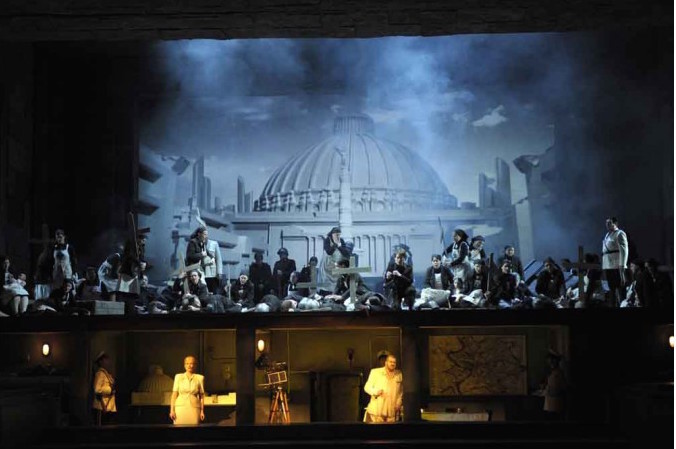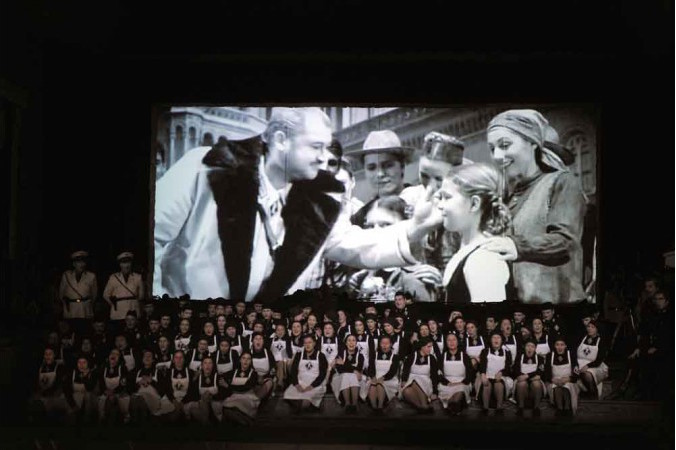In 2010, the Deutsche Oper Berlin staged a new production of Richard Wagner's Rienzi. The production, conducted by Sebastian Lang-Lessing and staged by Philipp Stölzl, was controversial due to the obvious similarity between the staging and the aesthetics of the infamous Third Reich. Unfortunately, Hitler's appropriation of Wagner's music reached its peak with Rienzi, as in January 1905, when he was 15 years old, he was so moved after seeing it in Linz, that he claimed it was the beginning of his messianic political mission. And his ghost haunted this production: a performance scheduled for April 20, 2012, had to be rescheduled due to the anniversary of the dictator's birth. Hitler identified himself with Rienzi, as he projected his persona into the main character's one: a man who emerged from the middle class of medieval Rome and rose to power in a turbulent and decadent era dominated by the nobles. Yet this medieval leader was overthrown by the very people who had brought him to the top, as, in the final stretch of his second term, he became a degenerate and oppressive tyrant. Nevertheless, this nationalist teen weirdo projected himself into the part of the role that suited him: that of a messiah determined to redeem his people from the degeneration and decadence that, for the future dictator, was represented by the cosmopolitan Vienna, capital of the multiethnic Austro-Hungarian Empire.
As the musical team remarks in the "making of" section of the DVD, the historical events of the 20th century cannot be ignored in a modern reading of the work. Wagner's Rienzi is a dictator who seizes power with supposedly noble intentions, only to later become an autocrat, which will help his enemies overthrow him. And even more so, for them, it cannot be ignored given the two totalitarian regimes that haunted Germany in the last century: Nazism and Communism.
As the overture plays, Rienzi is seen in his imposing office, inspired by Hitler's Chancellery: sober, cold, and imposing. The protagonist listens to the music from a gramophone, then becomes enraptured as the music plays. In the background, an impressive window overlooks a landscape dominated by snow-capped mountains, as if we were at Hitler's Berghof. In this mood, he begins to do somersaults. At one point, his sister Irene appears, characterized as the prototype of the "Aryan" German woman: blonde, conservatively dressed, and with the iconic braided hairstyle, like Magda Goebbels, on whom she seems to be inspired, or Gertrud Scholtz-Klink, the infamous leader of the National Socialist Women's League. Irene kisses Rienzi on the lips, something that will happen in other moments in the show: it is an incestuous relationship, as would later be seen between Siegmund and Sieglinde in The Ring, or reminiscent of Hitler's shady relationship with his niece Geli Raubal.
The first act seems to represent the Weimar Republic, with painted sets of enormous skyscrapers and cranes, a futuristic aesthetic taken from Fritz Lang's film "Metropolis." Scenes of street violence and colorfully dressed people revolutionize the scene. The nobles are like gangsters, and Rienzi, wearing a leather jacket and accompanied by a few paramilitaries, restores order and seizes power. Adriano is an elegantly dressed young aristocrat who joins the cause. At the beginning of the second act, everyone sheds their colorful clothes and wears black: the women wear white aprons, and the men wear uniforms reminiscent of the SS: everyone is now part of a new and "free" Rome. Rienzi is now a dictator and, dressed in an imposing military uniform, gives energic, passionate speeches. At the back of the stage, a screen shows images of Rienzi and his enthusiastic people listening to him, with iconography reminiscent of Leni Riefenstahl's infamous film "Triumph of the Will." Also shown is a weekly magazine called "Das neue Rom" or "The New Rome" in German, reminiscent of Nazi newsreels. From the third act onwards, Rienzi's bunker is shown, where the dictator, already in decline, gives speeches while his health was failing. In the famous prayer aria of Act Five, Rienzi plays with models of enormous buildings, including a large dome, reminiscent of the model of the new Berlin that Hitler had commissioned from Albert Speer. Violence is part of the work and is visible in the slow-moving battle scenes in Acts Three and Four, the latter showing women grieving for their dead, a powerful recreation of devastation. In the Finale, Rienzi is beaten, and with his face covered in blood, he curses the Romans and dies. Down in the bunker, Hadrian embraces Irene's body, while above, over Rienzi's corpse, the people praises Baroncelli and Cecco del Vecchio, as the curtain falls.
Considering that other attempts to represent Wagner with iconography based on the Nazi era have failed, even leading to their cancellation, this iconographic imitation with a runic R replacing the swastika, black uniforms, newsreels and the Irene-Magda Goebbels... I think the Berlin State Opera has succeeded in its experiment.
With the available material, a performance of the entire music from this opera would take around five hours. But in this version, it has been reduced to two and a half hours, not including intermissions. Lang-Lessing conducts an inspired Deutsche Oper Berlin Orchestra, with a chorus that performs wonderfully.
Torsten Kerl has performed Rienzi many times over the past decade, and in fact, the two main video references of this opera feature him in the title role. Kerl is devoted to the character, but his voice is rather lyrical and he lacks heroism at times, even when he does command the role. Still, the best moment, the prayer in Act Five, is well sung. He appears even more heroic in the 2012 video he filmed in Toulouse.
Camilla Nylund plays Irene. At the time, Nylund, a very beautiful woman, was 42 years old and she was in her prime. Her voice is more suited to these roles, and as Irene, she excels with a beautiful, dark-toned voice, suitable here but not enough for other roles she's recently taken on, such as Isolde or Brunhilde. Furthermore, her spectacular physique fits the vision of an "Aryan" woman that this production calls for for her character.
Kate Aldrich is the best performer in the cast, with a beautiful voice and passionate singing, as well as her acting skills, which perfectly embody a young and impulsive Adriano, who at the same time realizes when things are going wrong, both when he decides to follow Rienzi and when he abandons him. A great performance.
The rest of the cast is of a decent level, including Ante Jerkunica's Colonna and tenor Clemens Bieber's Baroncelli.
The fact that the Bayreuth Festival has decided to program this grand-opéra for the first and only time, has drawn my attention to this difficult work, which I was able to see live in Madrid in 2012, in a concert version. I can certainly say that this is the most interesting staging of this opera, in terms of its video versions, although musically the one in Toulouse, with Kerl himself reprising his role and maestro Pinchas Steinberg conducting, is better. We are waiting the Bayreuth performances, a historic event that we will follow closely via streaming. In the meantime, it must be said that this work, while not Wagner's best, is interesting enough to enjoy, especially if it is staged. I think it should be performed more often.






No hay comentarios:
Publicar un comentario